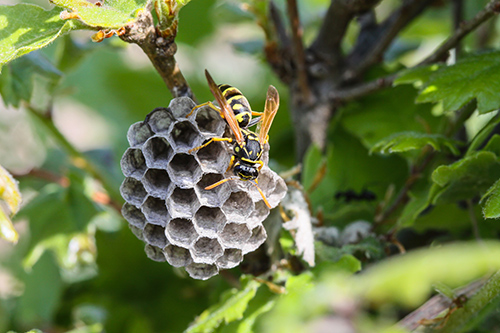Corporate Office:
20 Corporate Park Drive, Suite 150
Pembroke MA 02359
Cambridge, MA Office:
2534 Massachusetts Ave,
Cambridge, MA 02140
July 17, 2025

If you’ve noticed more wasps buzzing around your home or yard during the summer months, you're not imagining it. Summer is peak nesting season for wasps, and understanding why can help you protect your property and your peace of mind.
At Secured Environments, we believe in proactive pest control—and that starts with education. Here’s a closer look at the life cycle of a wasp, and why activity spikes during the warmest months of the year.
The life cycle of most wasp species begins in early spring. After overwintering in a sheltered location, a fertilized queen emerges as temperatures rise. Her first priority is finding a safe place to start building a nest—commonly under eaves, in attics, trees, or sheds.
She begins construction of a small paper-like nest using chewed wood pulp and saliva, and lays her first batch of eggs. These hatch into sterile female worker wasps, who soon take over the tasks of expanding the nest, gathering food, and protecting the queen.
By mid to late summer, the wasp colony is at full strength. This is when you're most likely to see increased activity around your property. The worker wasps are busy foraging for food, often attracted to sugary drinks, ripe fruits, garbage, and outdoor meals. It’s also when colonies are the most territorial and aggressive, especially if they feel their nest is threatened.
During this stage, nests can grow quickly—sometimes housing hundreds or even thousands of wasps. Unfortunately, this is also when they become a nuisance or even a danger to people and pets, especially for those allergic to stings.
As summer fades into fall, the queen starts laying eggs that will become new queens and males instead of sterile workers. These reproductive wasps leave the nest to mate. Once that process is complete, the current-year colony begins to die off. The original queen and the workers perish, and only the newly fertilized queens survive by finding a place to hibernate through the winter.
Because wasp activity peaks in summer, this is the most important time to be vigilant. If you see wasps entering the same area repeatedly—such as a hole in your siding or roofline—it may be a sign of an active nest nearby. Leaving it untreated can lead to stings, structural damage, and safety risks.
At Secured Environments Pest and Wildlife Services, we specialize in safe, effective wasp nest removal and long-term prevention. Whether you’ve spotted a small nest or you're dealing with a full-blown infestation, our licensed professionals are ready to help.
Don’t wait until a backyard BBQ turns into a sting operation. Contact Secured Environments Pest and Wildlife Services today for expert wasp control and prevention services tailored to your home or business.